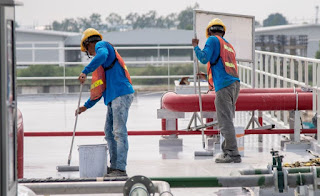Bad bathroom waterproofing, causes very costly
waterproofing repairs and disruption to homeowners. This problem is more common
than people think, even in relatively new buildings as well as in existing
homes when bathroom remodeling is being carried out. Bathroom waterproofing
repair can involve significant work because tiles, fixtures, floor tile
bedding, and so on need to come out for the waterproofing to be revamped. Based
on my personal experience, below are the 10 important mistakes and reasons why
bathroom waterproofing fails.
The following mistakes come to mind, when looking
back at so many of my bathroom waterproofing jobs, carried out over the years.
If you are considering a Bathroom Waterproofing Melbourne, the below
information will be helpful.
1. Striving to do the waterproofing job yourself, yet having no idea and
not following the waterproofing material data sheet and application
instructions.
2. Giving the job to an unlicensed and unqualified person and not requesting
warranties for the job in writing.
3. Floor and wall surfaces can be cement, wood chipboard paneling, or
cement fibre boards, not prepared and primed appropriately before joining the
waterproofing membrane material.
4. Not giving the waterproofing membrane material enough time to settle
before applying cement and sand bedding or gluing tiles to it.
5. Ineffectual sealing of floor to wall and wall to wall corner details,
where there is a lot of action due to temperature fluctuations which is a
problem with cement fibre sheeted walls on timber framing.
6. Not having the membrane turned up under the bathroom door space with an aluminum
or brass angle set into the floor. This is a very general blunder and surely
avoidable.
7. Defective sealing around pipe and tap wall insertions in shower cubicles
and bathtubs, usually because the plumber had no consideration to detail or
used the incorrect sealant, leading to water drooling into the wall. In some
cases, the restoration is not so large or complex, but will still cost money.
8. The tiler applying the incorrect type of adhesive for wall tiles.
9. The plumber should carry a water pressure test on the water pipes, by
leaving the pipes underwater pressure for 24 hours and do a visual examination
for any water leaks before the walls are sheeted to assure that that are no
pinholes in the system where water can gradually drip and find its way under
the bathroom floor and surrounding spaces. In some of the waterproofing
rectification jobs, the culprit for the water leaks from under the bathroom
floor turned out to be a minute hole in the water pipe in the wall which kept
dripping gradually and drenching the area around it.
10. Finally, if you are going to do the bathroom waterproofing yourself, you
must understand the manufacturer's datasheet for the material or the directions
on the sealant or other packaging of waterproofing materials. Go through the
application and other manufacturers' guide thoroughly and take the time to do
the job.
Please take the bathroom waterproofing seriously
and don't try to save money on this essential part of the remodeling work in
your bathroom. I hope that this information was valuable to you so that you
avoid the bathroom waterproofing blunders posted up.
For Bathroom Renovations Melbourne, AK Tiling and renovations is
qualified to give you the best bathroom repair and remodeling solutions. Visit
the official website to get more details on bathroom repair and remodeling.

These types of suggestions are very useful to us. You are providing good knowledge of bathroom waterproofing. Thank You for sharing wonderful Blog
ReplyDeleteThis article is a gem! Thanks for the valuable insights.
ReplyDeleteResidential Tiling